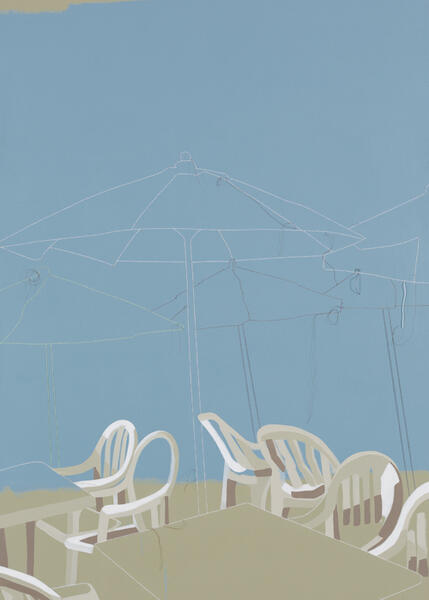Aníbal Vallejo
Duque Arango, Medellín
In Aníbal Vallejo’s recent series of paintings, different references to the history of painting may be perceived, among them, references to Claude Monet’s

Nymphéas. Effet du soir (1897-1898), Henri Matisse’s Dance (I) (1909), Jacques-Louis David’s Le Premier consul franchissant les Alpes au col du Grand-Saint-Bernard (1800), Edouard Manet’s Le Déjeuner sur l'Herbe (1863), David Hockney’s Domestic Scene, Los Angeles (1963), or François Boucher’s Portrait of Marie-Louise O'Murphy ( ca 1752). They are drawn in some cases with paint, in other cases they are embroidered, and they are superimposed on color blots, which in most cases contextualize those references associating them with the artist’s experiences.
The artist’s interest in the classic themes of painting are evident here; all the images record Vallejo’s rendering of landscape, that painting genre despised as being señorero (typically, a lady’s activity), as he himself states, but one that historically conveys serenity, beauty and immensity. And his concern with the landscape goes beyond the observation of the horizon in the natural environment and of everything that can be found between here and that “there”. It focuses on the man-made constructions which prevent our viewing that horizon; on those walls which obstruct the landscape and which he conveys through the use of large color blots, placing his renderings in the outside space, which may be his own or a reference to the baroque period, bringing to mind the modern premise of Baudelaire’s window: not to look out of a window but to look from outside into an open window, and discover that “ in that black or luminous square life lives, life dreams, life suffers.”
And it is precisely in the configuration of these paintings that those placid places that Vallejo pretends to show us are generated; those places composed of fragments of his everyday life, of his dreams, or of his treatment and projection of art history through the most intimate of his resources, embroidery. Places which alternate and coexist with reality, and which “ were conceived in the minds of men, or to tell the truth, in the interstices of their words, in the depths of their stories, or in the place without place of their dreams, in the void of their hearts; I am referring, in short, to the sweetness of utopias,” as stated in 1966 by Michel Foucault, the other great reference in this exhibit, which simultaneously sets the course for the show and lends it consistency.
-
 Parasol. 2013.
Parasol. 2013.
Acrylic and hand embroidery on canvas, 47.2 x 31.5 in. / Acrílico y bordado manual sobre lona, 120 x 80 cm. Photograph / Fotografía David Estrada & Julián Roldán. Courtesy of the artist/Cortesía del artista.




